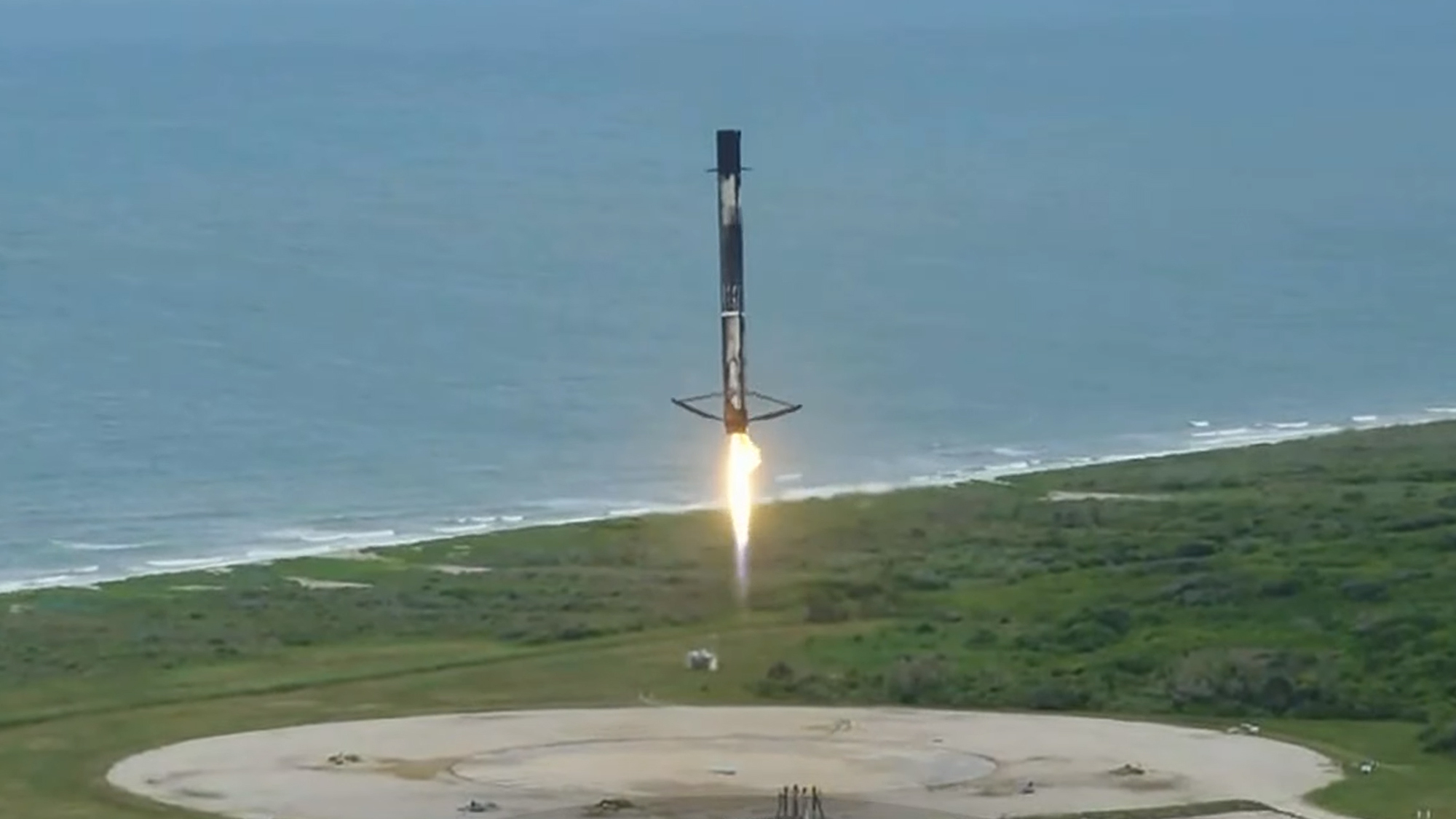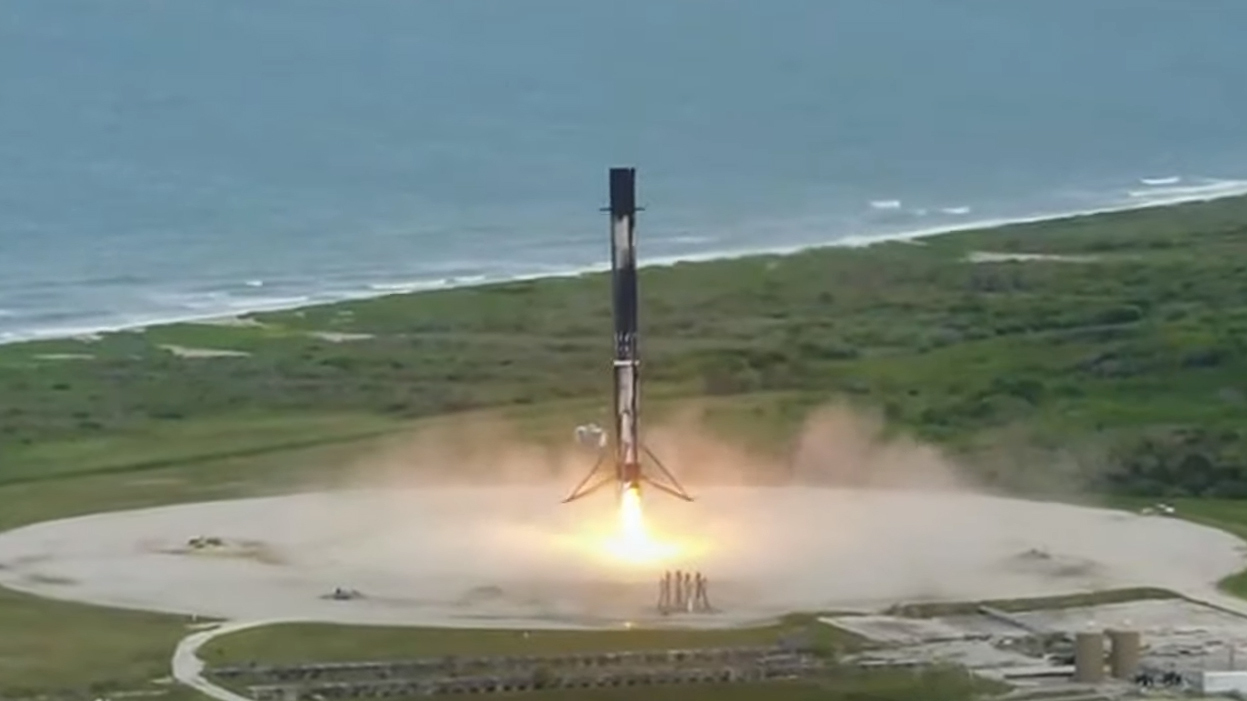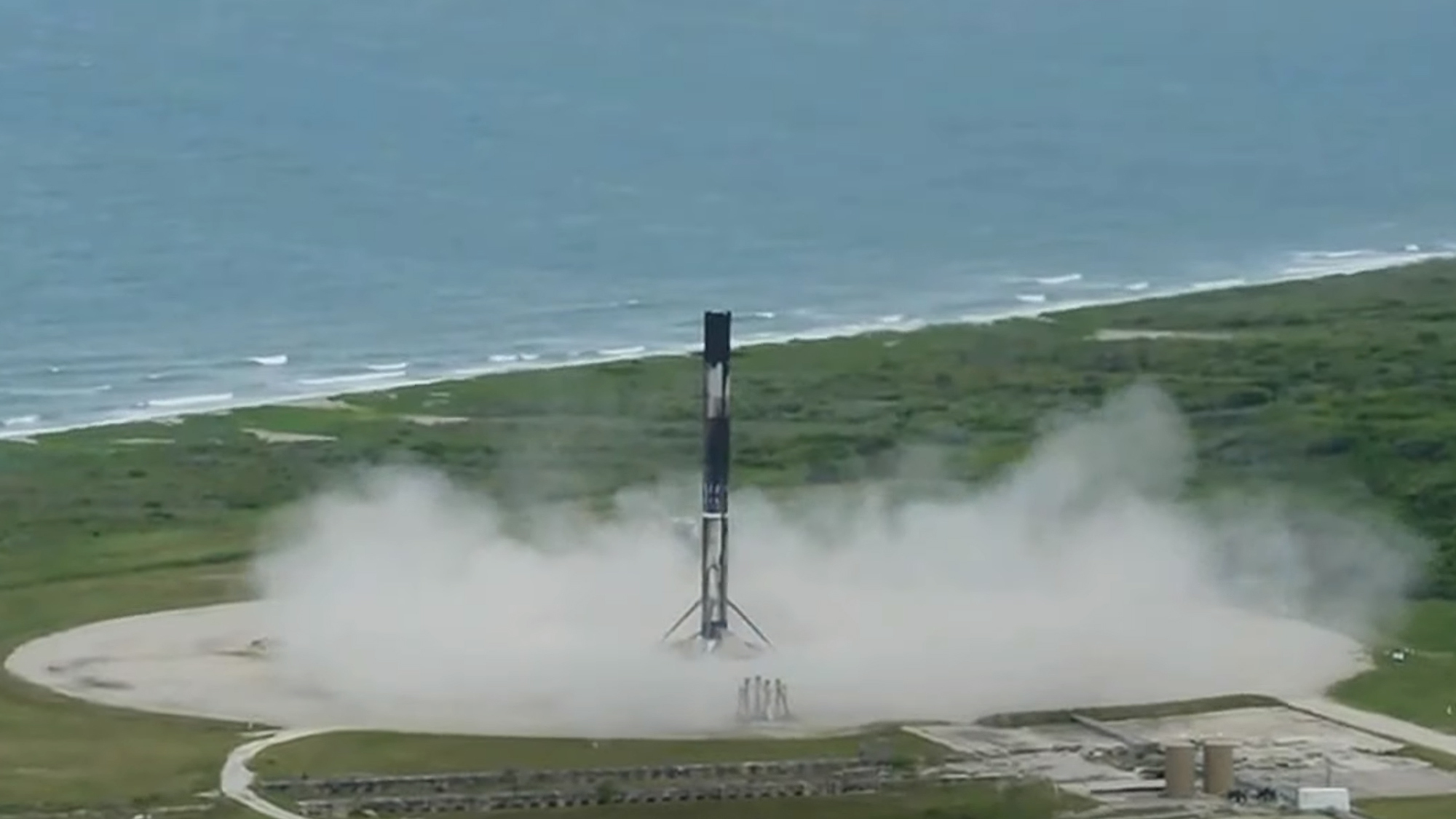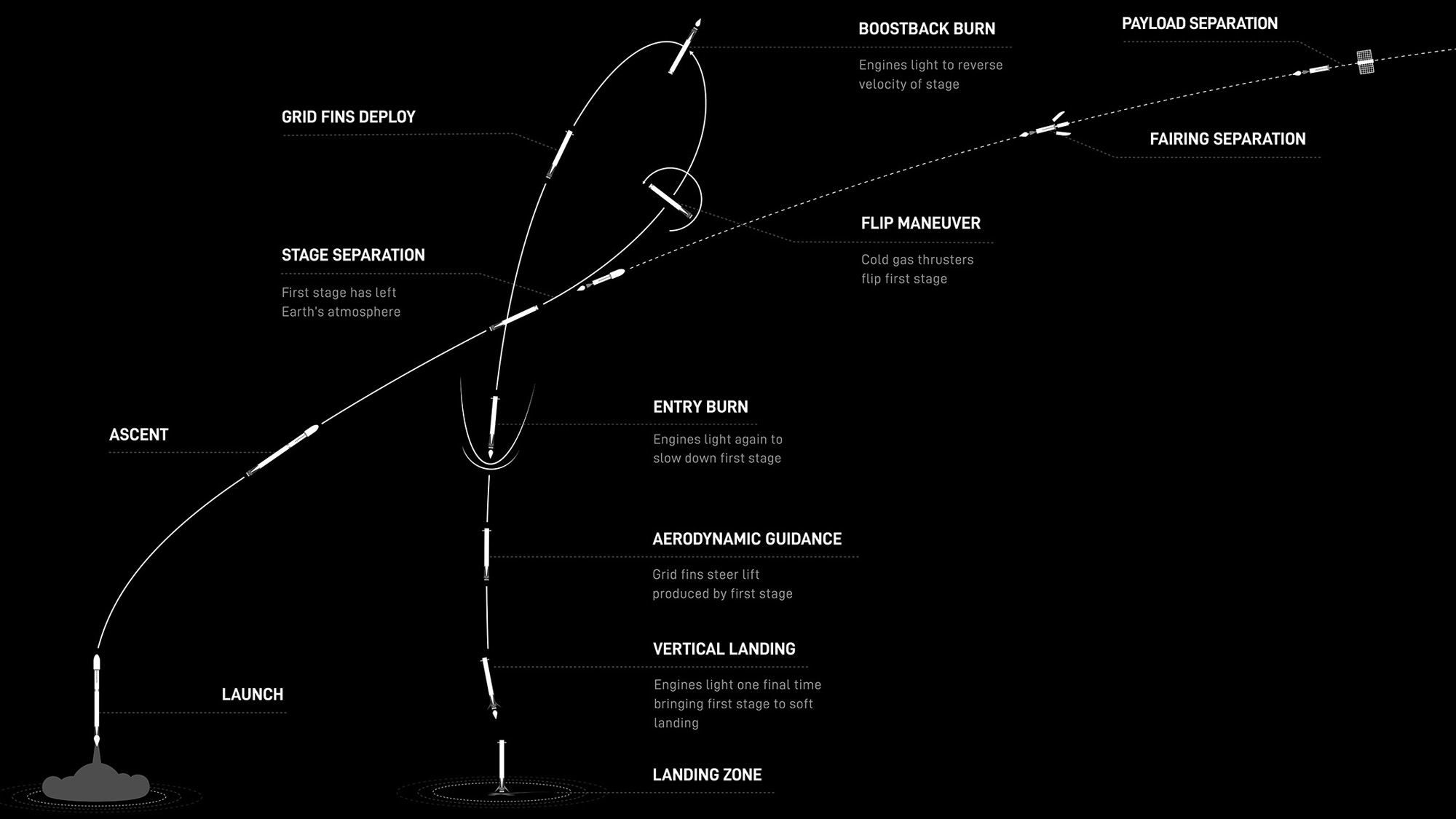SpaceX launches 88 satellites into orbit and nails rocket landing
CAPE CANAVERAL, Fla. — SpaceX successfully launched an ambitious rideshare mission Wednesday (June 30) as one of its veteran boosters hoisted 88 small satellites into orbit before landing back on Earth.
The two-stage Falcon 9 rocket lifted off into a cloudy afternoon sky at 3:11 p.m. EST (1511 GMT) from Space Launch Complex 40 at Cape Canaveral Space Force Station here in Florida, following a 24-hour delay due to a range violation caused by a wayward plane in the restricted airspace around the launch site.
Originally slated to blast off last Friday afternoon (June 25), the complex Transporter-2 mission was delayed a few days to allow for more prelaunch checkouts. And then another 24-hours due to a range violation. SpaceX was just seconds away from launching one of its used Falcon 9 rockets packed with small satellites when the plane entered the safety zone, prompting the teams to scrub Tuesday's launch attempt.
Video: SpaceX launches Transporter 2 rideshare, nails LZ-1 landing in Florida!
Related: Watch a SpaceX rocket ace landing on a drone ship in stunning new video
Company founder and CEO Elon Musk was not happy about Tuesday's delay, tweeting that the incident is an example of how some changes need to be made when it comes to launch restrictions.
"Unfortunately, launch is called off for today, as an aircraft entered the 'keep out zone,' which is unreasonably gigantic," Musk wrote on Twitter. "There is simply no way that humanity can become a spacefaring civilization without major regulatory reform. The current regulatory system is broken."
On Wednesday, however, there were no planes to stand in the Falcon's flight path, and the rocket blasted off right on time, roaring overhead as it soared through the atmosphere.
Breaking space news, the latest updates on rocket launches, skywatching events and more!
The overhead cloud layer made for great acoustics as the rocket's first stage returned to the Cape after separating from the upper stage. Sonic booms, which happen when a spacecraft travels faster than the speed of sound, cracked overhead as the booster made its way through the atmosphere. And with warm, humid conditions in Florida, the sound of the sonic boom traveled faster than it would have in cold, dry air.
Perched atop the veteran launcher was a stack of 88 small satellites — 85 for commercial and government customers and three of SpaceX's own Starlink internet satellites — which flew to space together as part of the company's second dedicated rideshare mission, called Transporter-2.
The flight allowed SpaceX to flex its ridesharing muscles in a carefully choreographed orbital ballet as its flagship rocket ferried a hefty load of tiny satellites. (In total, the satellites weighed as much as the 143 satellites that launched on SpaceX's previous rideshare mission, Transporter-1, earlier this year.)
Acting as a cosmic carpool, SpaceX sent the bevy of small satellites into space, depositing them into a polar orbit. As such, the rocket appeared to launch straight overhead and into the clouds as it leaped off the pad this afternoon.
Following a successful liftoff, the Falcon 9's first stage landed on SpaceX's dedicated landing pad, LZ-1, a few miles from where it launched. The touchdown marked the 89th recovery of a first-stage booster for SpaceX and the first land landing of the year. (SpaceX's previous 19 launches this year landed their first-stage boosters on one of the company's two drone ships, "Of Course I Still Love You" and "Just Read The Instructions.")



The launch marks the 20th mission this year for SpaceX and the company's fourth within a month from Florida's Space Coast.
The rocket powering today's mission is one of SpaceX's frequent fliers, marking its eighth flight on the Transporter-2 mission. Known as B1060, the booster first entered service one year ago today, on June 30, 2020, as it carried an upgraded GPS III satellite for the U.S. Space Force.
Following that flight, the booster has carried five different groups of SpaceX's own Starlink internet satellites, helping to build out its burgeoning mega constellation. It also ferried a communications satellite into orbit for Turkey.
For its eighth act, which came just over two months after its last flight, the veteran Falcon 9 acted as a space taxi service to deliver the 88 satellites to orbit. The mission marks the second in a dedicated series of rideshares as part of a program SpaceX created to help smaller satellites get into space by sharing a ride and reducing costs.
The company announced in 2019 that it would offer rides on its Falcon 9 rockets at certain intervals throughout the year and for $1 million per launch. Those flights can be booked through a dedicated website that SpaceX created.
Officials at the Space Development Agency (SDA) — a government agency designed to shake up how the government thinks about space and in particular satellites in space — say that these types of rideshare missions are changing the way people access space.
"The whole Transporter mission concept is brilliant," Derek Tournear, director of the SDA told Space.com. "The concept is like a bus that launches every so often, you just get on when you're ready to go."
Related: See the evolution of SpaceX's rockets in pictures
A fleet of tiny satellites
The Transporter-2 rideshare mission was in part facilitated by Spaceflight Inc., which helps paying customers looking to launch small satellites book their perfect ride to space.
Until recently, smaller satellites have had limited options, squeezing in on missions wherever there's room. But as launch costs decrease and with the advent of rideshare missions like this one — as well as the rise of smaller launchers like Rocket Lab's Electron and Virgin Orbit's services — smaller satellites have more options than ever on hitching a ride to space.
However, launching that many satellites at once is no easy task. Each one has to deploy in a timed sequence so as to avoid potential collisions. To address that challenge, specialized launch dispensers are used and free-flying transfer stages that will then deploy payloads once they are in a certain orbit.
The deployment sequence is carefully timed, with each satellite releasing at just the right time. This minimizes any potential inflight anomaly.
Related: Russia says SpaceX Starlink satellite and space junk may narrowly miss Progress cargo ship in orbit
Deployment of 3 Starlink satellites confirmed pic.twitter.com/MTRvmoXxyDJune 30, 2021
The SDA, which is no stranger to space anomalies, after its set of Mandrake satellites — a joint project for DARPA, the Air Force, and the SDA, the satellites are part of the Blackjack project which demonstrates satellite technologies for military applications — were accidentally damaged earlier this year. Originally slated to fly on Transporter-1, the satellites were damaged during the loading process before launch.
Tournear said that sometimes these things do happen, but thanks to the flexibility of the Transporter mission model, they were ready to fly again within nine months — a feat that historically would have taken much much longer, but the rideshare opportunity coupled with advances in satellite manufacturing facilitated the quick turnaround.
The SDA has several launches planned out, including dedicated SpaceX missions over the next several years. For this flight, the small cubesats will serve as part of a technology demonstration mission.
Two other satellites, designed and built by General Atomics, will play into the SDA's overall mission of improving satellite operations in space.
The Optical Communication Terminal (OCT) duo will test how satellites communicate in orbit. After deploying from the Falcon's upper stage, the pair will slowly drift until they're about 300 miles (500 kilometers) apart.
At this point, the OCT satellites will try to communicate with each other. They will then test sending images, videos and other types of data transmissions back and forth. The pair is also equipped with an infrared imaging payload designed to observe areas on the ground.
The ultimate goal is to improve the resiliency and security of the communications and to eventually test satellite-to-UAV (uncrewed aerial vehicle) communication technologies as well.
Also on board Transporter-2 was a group of small satellites called Space Bees. These tiny satellites have a goal of demonstrating two-way communication between cheap and low-data satellites. They could also help provide affordable internet in hard-to-reach parts of the world that do not yet have reliable access.
Nanoracks has three payloads on Transporter-2. Called Lemur, the constellation of satellites are built and operated by Spire. Designed to help with Earth observations and traffic monitoring, the constellation uses GPS signal occultation to measure pressure, humidity, and temperature.
Lemur is also used to monitor trade, prevent piracy, track assets, assist in search and rescue operations, and help prevent illegal fishing.
These are just some of the many satellites nestled inside the Falcon's payload fairing.
Polar flight
The launch trajectory for this mission is also a bit unique. It will follow a similar path as one that launched last summer from Cape Canaveral. After liftoff, the rocket hugged the east coast of Florida, heading south over the Atlantic ocean so it could deposit its payload into what's known as a polar orbit. This type of orbit allows the satellites to fly over the planet's poles.
Typically these types of flights launch from the West Coast as they can more easily avoid populated areas. However, last summer, SpaceX received permission to launch flights bound for polar orbits for the first time in the modern era of spaceflight, thanks to one of the Falcon 9's unique features: an automated flight termination system.
That system is designed to destroy the rocket in case something goes amiss during flight. (Historically, there would be a human in charge of the system, which isn't as precise as a computer.) Currently, the Falcon 9 and the Falcon Heavy are the only two launch vehicles at the Cape with this capability.
However, the U.S. Space Force has made it a requirement that all future launch vehicles have this capability by 2023. Not only does it unlock unique launch trajectories, but it also facilitates a more rapid launch cadence.
Along with recovering the first stage booster, SpaceX will continue its efforts of recovering the clamshell-like hardware surrounding the stack of satellites, called the payload fairing (or rocket's nose cone).
To that end, SpaceX has contracted a boat called the HOS Briarwood. The vessel will scoop the fairings — which are making their third flight — out of the ocean following the launch.
Follow Amy Thompson on Twitter @astrogingersnap. Follow us on Twitter @Spacedotcom or Facebook.

Amy Thompson is a Florida-based space and science journalist, who joined Space.com as a contributing writer in 2015. She's passionate about all things space and is a huge science and science-fiction geek. Star Wars is her favorite fandom, with that sassy little droid, R2D2 being her favorite. She studied science at the University of Florida, earning a degree in microbiology. Her work has also been published in Newsweek, VICE, Smithsonian, and many more. Now she chases rockets, writing about launches, commercial space, space station science, and everything in between.



